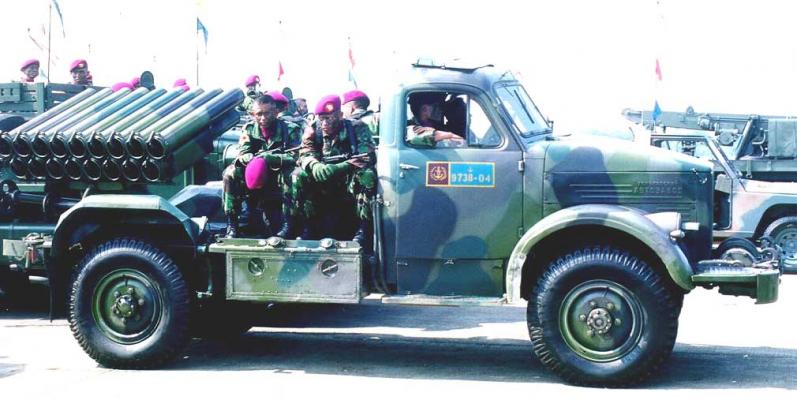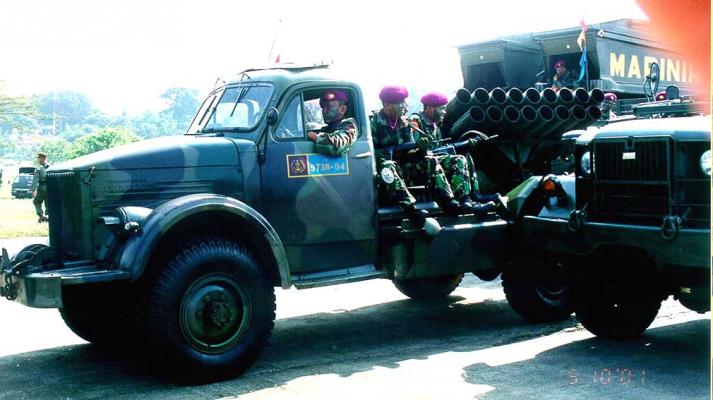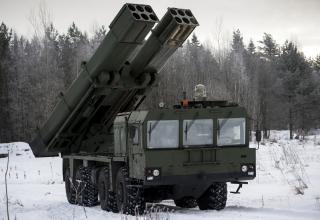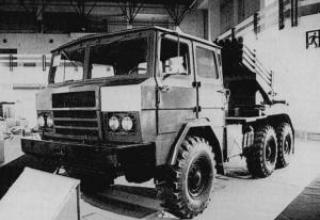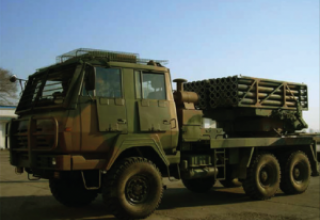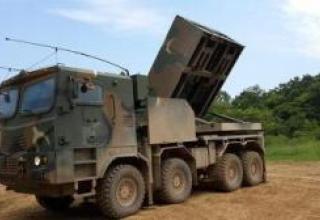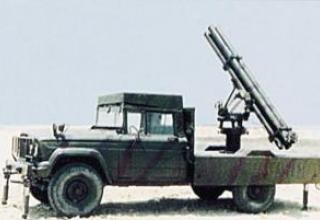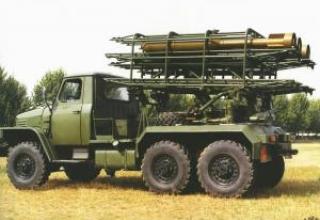The BM-14-17 (index 8U36) launch vehicle was designed to suppress the enemy's manpower and firepower, to destroy and suppress artillery and mortar batteries, to destroy the enemy's motorized vehicles, to destroy light tree and earth field structures.
The development of BM-14-17 was carried out under the supervision of Chief Designer A.I. Yaskin and was completed in 1958. BM-14-17 was created taking into account the experience gained during the design of other combat vehicles of the BM-14 family, and was fully unified with them in terms of applied ammunition.
Combat vehicles of this type were first of all delivered to the Navy rocket artillery detachments. BM-14-17 had been produced by the Soviet defense industry for a long time, was repeatedly upgraded and was in service with many countries.
Composition:
The BM-14-17 (BM-14-17M index 8U36M) launch vehicle is a self-propelled rocket launcher, consisting of an artillery unit and a modified truck chassis.
The artillery part consists of seventeen barrels (upper row - 9, lower row - 8), cradle, base with rotating, lifting and balancing mechanisms and a traveling lock, sighting device, electrical equipment and special equipment on the chassis. The cradle is used to attach the barrels, sights and electrical equipment. The cradle is a rigid welded box, which is connected to the base by axles and forms a swinging part of the combat vehicle. The base consists of pin, pin guard, swiveling, lifting and balancing mechanisms, and traveling lock mechanism. The pin, which is mounted on bearings in the pin casing, together with the swinging part and the swiveling and balancing mechanism, is the rotating part of the combat vehicle.
The swinging mechanism is worm-type, and the lifting mechanism is screw type. A spring-loaded, pusher-type balancing mechanism is used to reduce the force on the flywheel handle of the lift mechanism drive. The stopping mechanism is intended for stopping of rotating and oscillating parts of the machine in a walking position. With the help of guidance mechanisms the guide package can be guided in the vertical plane in the range of angles from 0° to +50°, the horizontal firing angle is 140° (70° to the left and right of the longitudinal axis of the machine).
The sighting unit consists of a sight and a panorama view. When shooting at night, the reticle scale and panorama are illuminated by a special system powered by batteries of the combat vehicle's chassis.
A modified chassis of GAZ-63 and GAZ-63A trucks was used as a base for BM-14-17. The modified chassis of GAZ-63 differed from GAZ-63A only by the presence of a winch placed at the front end of the frame in front of the radiator and driven by the vehicle engine. Special equipment of the combat vehicle chassis consists of a seat, cabin protection, front and middle decking, awning stand, a ZIP box, a spare wheel bracket and jacks. The BM-14-17M combat vehicle was located on the chassis of GAZ-66 (see schemes in combat and marching position).
When the launcher is moved from a camping position to a combat observation glass, the cabs are closed with folding armour panels and the rear part of the chassis is hanged above the ground with the help of two supports with screw jacks. This takes about 1.5 minutes. The launcher can be fired in single shots, but the main mode of fire is in volleys. The duration of the volley is 7-10 seconds. Firing is controlled from the cab of the vehicle or by remote control at a distance of up to 60 m from the combat vehicle. The launcher is manually charged for 1.5-2 minutes. The combat design of the launcher consists of seven persons. On the march, the commander of the vehicle and the driver are placed in the cockpit, while the other members of the calculation are placed on the seats mounted open behind the cockpit. The combat vehicle, loaded with 17 shells can march up to 650 km without additional fueling and open salvo fire 1-2 minutes after the command "To battle".
The main type of projectile for BM-14-17 (BM-14-17M) was a 140-mm M-14-OF spin-stabilized rocket (see description).
In addition to the M-14-OF fragmentation blowout projectile, the ammunition of these combat vehicles included M-14D smoke-smoking projectiles (see description).
The 140 mm spin-stabilized rockets with a warhead equipped with warfare agents were also designed and produced.
See additional materials on our website:
Characteristics:
| Feature | BМ-14-17 | BМ-14-17М |
| Dimensions in camping position, mm: - length with winch - no winch length - width - altitude |
5700 5300 2015 2310 |
5655 - 2340 2440 |
| Height at highest elevation angle, mm | 2300 | 2450 |
| Weight, kg: - loaded PM with the calculation - BM without shells and calculation - artillery unit - trunk - cradle - grounds - fender frames - seats |
5400 4200 1332 12 87 305 108 168 |
5825 4600 1332 12 87 305 - - |
| Minimum time required to produce a full salvo, sec | 7-10 | |
| Time of transfer from marching position to combat without charging, sec: - without awning - awned |
60 120 |
|
| Time of transfer from combat to marching (without setting up a tent), sec | 180 | |
| The time it takes to charge a combat vehicle, sec | 90-120 | |
| Lift (swivel) drive handle force, kg | till 8 | |
| Change of elevation angle in one revolution of the lifting gear drive flywheel | 0°40' | |
| Changing the swing angle in one turn of the rotary handwheel | 1°45' | |
| Maximum speed of a charged PM, km/h. | 65 | 90 |
| Maximum pulling force of winches, kg | 3500 | |
| Highest ford depth with hard bottom, overloaded by charged PM, mm | 800 | |
| The highest lift over a charged PM in dry and hard ground, ° | 35 | - |
| The height of the center of gravity of the combat vehicle, mm: - with the shells and the calculation. - without shells and without calculating |
- - |
1180 1024 |
| Number of trunks, pcs. | 17 | |
| Inner barrel diameter, mm | 140,3 | |
| Barrel length, mm | 1100 | |
| Angle of elevation, hail: - minimum - maximum |
0 +50 |
|
| Rising angle in horizontal aiming sector from +33°30' to +119°30' (from the main firing direction), ° | 19-50 | |
| Main firing direction from the longitudinal axis of the machine to the left | 76°30' | |
| Angles of horizontal aiming from the main firing direction, hail: - at elevation angles from 0 to 19° - at elevation angles of 19 to 50 degrees |
±33°33' and +119°30' to +166°30'. from -33°30' to +166°30'. |
|
| Panorama eyepiece height, mm | 1635 | 1630 |
Testing:
As of 01.01.1950, in July 1949 the projectile successfully passed the state tests.
At the time of drawing up the document at the factories of gross production was producing a batch of shells for military tests.
According to data from 1977, the specialists of the Israel Military Industries (Israel Military Industries) developed a 240 mm projectile designed to fire a 12-charged war machine (launcher).
The body of the combat vehicle (combat unit) was manufactured by forging method with high precision machining. When the combat unit is torn, about 1,200 steel fragments with a 12,000-square-metre chima killer will break off. When 12 rounds are fired in volley at a range of 10,000 square metres, an area of 125,000 square metres is hit. A circular variation of 0.8% of the range is possible.
The turbojet projectile can be equipped with an instant or slow motion fuse (0.5 second deceleration). A non-contact fuse may be fitted if required.
The engine is designed with 16 nozzles (nozzle openings), after which the combustion products are allowed to rotate to stabilize the projectile. It also includes seven solid fuel draughts and an electric ignition mechanism. The pressure in the combustion chamber is 150 atm; the traction force is 4000 kg, the combustion time is 1.2 s and the total impulse is 4800 kg/s.
Main characteristics of the projectile
| Length | 1290 mm |
| Weight, kg: | |
| shell | |
| full | 110,5 |
| after a fuel burnout | 85,8 |
| combat unit | 30 |
| BB (TNT) | 18,3 |
| fuels | 24 |
| Firing range, m (at an elevation angle of 45°) | 10 700 |
| Shot rate, m/s. | |
| initial | 40 |
| at the end of a fuel burn | 400 |
| when faced with an obstacle | 270 |
For storage and transportation, the projectile is placed in a polystyrene container, the fuses are placed in wooden containers.
Sources:
- Боевая машина БМ-14-17 (ИНДЕКС 8У36). Руководство службы. Военное издательство Министерства обороны Союза ССР. М.: 1960. – С. 3, 146-147.
- Боевые машины БМ-14-17 и БМ-14-17М (Индексы 8У36, 8У36М). Руководство службы. Военное издательство Министерства обороны СССР. М.: 1983. – C. 3, 5, 7, 10-11.
- Шунков В.Н. Энциклопедия Реактивной артиллерии. Минск.: ОАО “ПОЛИГРАФКОМБИНАТ ИМ. Я.Коласа”. – С.185.
- Jane’s Armour and Artillery 1986-1987. – London: Jane’s Publishing Limited, 1988. – P. 766.
- Красная звезда. - 29.08.1974 г. - №202(15470). - С. 1.
